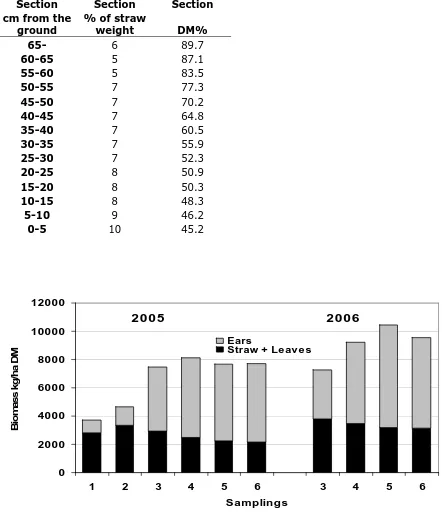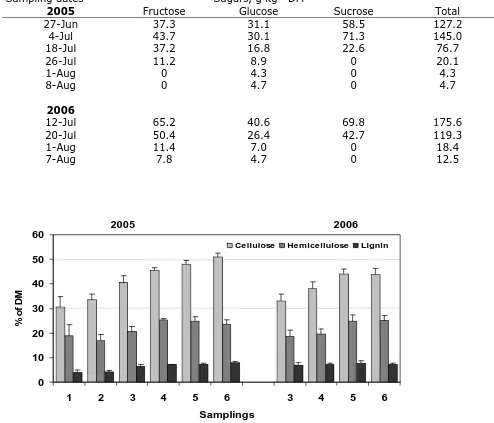NJF Report • Vol 3 • No 4 • Year 2007
NJF Seminar 405
Production and Utilization of Crops
for Energy
Vilnius, Lithuania, 25-26 September 2007
Nordic Association
Straw biomass – potential raw material for ethanol production.
Markku Kontturi and Katri Pahkala
MTT Agrifood Research Finland,Plant Production, FI-31600 Jokioinen. Telephone: +358 3 4188 2458, fax: +358 3 4188 2437,
e-mail: markku.kontturi@mtt.fi
Abstract
The aim of the study was to estimate the optimal harvest time and overall potential of barley straw as feedstocks for bioethanol production. Samples from field trials in Finland were collected during the seasons 2005 and 2006. The total biomass yield of barley was in the range of 8-10 metric ton (dry mass) per hectare, whereof the lignocellulose-rich straw (including leaves) generated only app. 30%. The maximum dry mass yields of straw were measured for the samples taken during the normal grain harvest time (first week in August). The carbohydrate proportion of the crops in different culture phases varied significantly. The extremely dry summer of 2006 also affected the proportions in comparison to the “normal” summer of 2005. With straw, the combined cellulase and hemicellulose proportion of total dry mass grew significantly until the last week of July, where after only small increases were detected.
Introduction
The EU has established a goal to replace up to 10 energy-% of all fuel used in road transport with renewable fuels by the year 2020. The bulk of EU’s car fleet is running on either diesel or petrol. Ethanol can be mixed into petrol, but the current petrol specification, however, limits this mixing ratio to about 5 volume-%. Ethanol is predominantly produced from renewable raw materials and thus, the use of it as fuel should potentially decrease the consumption of fossil energy and the emission of greenhouse gases (GHG). The production of ethanol from sugar cane juice, corn starch and cereal grains using fermentation process is the conventional way to make ethanol. This process is, especially when corn and cereal grains are used as the raw material, rather cost- and energy-intensive as well as not optimal from a GHG emission perspective (Öhgren et al. 2005). Using lignocellulosic waste materials (Kim and Dale 2004, Linde et al. 2005) or high biomass-yielding grasses instead as the raw material for ethanol production could be a way to reduce the production costs, reduce the GHG emissions and avoid competition with the food sector.
MTT and VTT studied the availability and quality requirements of lignocellulose-based raw materials such as cereal straw and reed canary grass (RCG) (Phalaris arundinacea L.) to be used in bio-ethanol production. RCG is currently grown for large-scaled energy production (Pahkala et al. 2005), and spring barley is the best adapted cereal crop in the northern conditions. Optimal plant development stage and chemical composition of the biomass, as well as the technological preconditions to modify the raw material into a fermentative form were the key questions to be answered in the current project.
Material and methods
Field trials
Barley straw was harvested at six different phases of growth during the seasons 2005 and 2006 in Jokioinen, Finland. The first harvesting was at the early ear emerging stage, and the last at grain threshing (Table 1). The samples of barley were analysed for biomass yield and dry matter (DM) content, fibre components (cellulose, hemicellulose and lignin) and soluble sugars.
Table 1. Sampling dates for barley straw.
Chemical analysis of the raw material
For chemical analysis the plant samples were dried at temperature less than 40oC, and
pulverized to less than 1 mm diameter. The content of cellulose and hemicellulose was measured using the results for acid detergent fibre (ADF), acid detergent lignin (ADL), and neutral detergent fibre (NDF). ADF, ADL, and NDF were measured by the Fibertec™ 1020 (M6) System which follows methods with official approval as ISO 6865, 92/89 EEC and AOAC 2002.04 (feed) (FOSS, 2007). Soluble sugars such as fructose, glucose and saccharose were measured by liquid chromatographic determination (Nordic Committee on Food Analysis 1993).
Results
Biomass production
The total biomass yield of barley doubled between the ear emergence stage (1st sampling) and the yellow ripening stage (5th sampling) (see Fig. 1). At highest, the total DM yield was 8 and
10 tons ha-1 in 2005 and 2006, respectively. The straw yield was about 30% of the total
biomass. Harvestable straw biomass is considerably less (Pahkala and Kontturi 2006, Table 2). Normally at harvest the stubble height is in the range from 10 to 15 centimeters, ie. straw yield is 20 to 25 percent less than the potentially harvestable biomass.
Chemical composition of the raw material
The content of soluble sugars for barley straw was high at the ear emergence stage but decreased to a low level as grains started to grow (Table 3). Cellulose and lignin content of barley straw (incl. leaf blades and sheaths) increased until dough stage of grain (4th sampling) and changed only little until harvest. Changes in hemicellulose content were lesser (Fig. 2).
Sowing date of barley 2-May 2005 6-May 2006
Sampling phase Sampling dates 2005 Sampling dates 2006
1. 20% ear emergence (EE) 27-Jun 21-Jun
2. Full ear emergence 4-Jul 29-Jun
3. Two weeks after full EE 18-Jul 12-Jul
4. Early dough stage of grains 26-Jul 20-Jul
5. Yellow ripeness of grains 1-Aug 1-Aug
Table 2. Dry matter (DM) content and weight of barley straw sections in 2006.
0 2000 4000 6000 8000 10000 12000
1 2 3 4 5 6 3 4 5 6
Samplings
B
iom
as
s kg/
h
a
D
M
Ears
Straw + Le av e s
[image:4.612.89.521.444.660.2]2006 2005
Fig.1. Dry matter (DM) yield for barley in 2005 and 2006. Sampling dates from Table 1.
Section Section Section cm from the
ground % of straw weight DM%
65- 6 89.7
60-65 5 87.1
55-60 5 83.5
50-55 7 77.3
45-50 7 70.2
40-45 7 64.8
35-40 7 60.5
30-35 7 55.9
25-30 7 52.3
20-25 8 50.9
15-20 8 50.3
10-15 8 48.3
5-10 9 46.2
Table 3. Total soluble sugar content for barley straw at different development stages in 2005 and 2006.
Sampling dates Sugars, g kg-1 DM
2005 Fructose Glucose Sucrose Total
27-Jun 37.3 31.1 58.5 127.2
4-Jul 43.7 30.1 71.3 145.0
18-Jul 37.2 16.8 22.6 76.7 26-Jul 11.2 8.9 0 20.1 1-Aug 0 4.3 0 4.3 8-Aug 0 4.7 0 4.7
2006
12-Jul 65.2 40.6 69.8 175.6
20-Jul 50.4 26.4 42.7 119.3
1-Aug 11.4 7.0 0 18.4 7-Aug 7.8 4.7 0 12.5
2005 2006
0 10 20 30 40 50 60
1 2 3 4 5 6 3 4 5 6
Samplings
% o
f D
M
Cellulose Hemicellulose Lignin
Fig. 2. Cellulose, hemicellulose and lignin content for barley straw at different development stages in 2005 and 2006. Sampling dates from Table 1.
Discussion
(Table 3). Pre-anthesis assimilation was estimated to have contributed 44% of grain dry matter in a very dry, hot year, but only 11 per cent in a wetter, cooler year (Austin et al. 1980b). Celluloses and lignin content of barley straw (incl. leaf blades and sheaths) increased until dough stage of barley grain and changed only little until harvest. In maize more than half of the cell wall material accumulated after internode elongation had ended (Jung, 2003). Galactose and arabinose began to accumulate early in cell wall development, which was presumed to be associated with primary wall growth during internode elongation. The major secondary wall constituents did not begin to accumulate rapidly until shortly before internode elongation ended (Jung, 2003).
The DM yield of straw comprised 30% the total biomass of barley at grain maturing stage. However, the height of the cutting affects the straw yield. For example the stubble height of 15 cm will mean 25% less in straw yield (Saijonkari-Pahkala, 2001, Pahkala and Kontturi, 2006).
Conclusions
Barley straw was found to be suitable raw material for ethanol production. Straw could be easily pre-treated with steam explosion, hydrolysed to monosaccharides and fermented to ethanol. The optimum harvesting times for bio-ethanol raw material are at grain maturity for barley straw. Potential raw material, barley harvested at full ear emergence, when straw is rich in soluble sugars, need further research.
References
Austin, R.B., Bingham, J., Blackwell, R.D., Evans, L. T., Ford, M.A., Morgan, C.L., Taylor, M., 1980a. Genetic improvements in winter wheat yields since 1900 and associated physiological changes. Journal of Agricultural Science, 94, 675-689.
Austin, R.B., Morgan, C.L., Ford, M.A., Blackwell, R.D., 1980b. Contributions to grain yield from pre-anthesis assimilation in tall and dwarf barley phenotypes in two contrasting seasons.
Annals of Botany 45, 309-319.
FOSS 2007. http://www.foss.dk/Solutions/ProductsDirect/FibertecSystems.aspx (1 April 2007). Jung, H.-J.G., 2003. Maize stem tissues: ferulate deposition in developing internode cell walls. Phytochemistry, 63, 5, 543-549.
Kim, S., Dale, B.E., 2004. Global potential bioethanol production from wasted crops and crop residues. Biomass & Bioenergy 26, 361-375.
Linde, M., Galbe, M., Zacchi, G., 2005. Production of bioethanol from barley straw using simultaneous saccharification and fermentation. Proceedings of the 14th European Biomass Conference – Biomass for Energy, Industry and Climate Protection, Paris (2005), 1211-1214. Nordic Committee on Food Analysis. Fructose, glucose and saccharose, NMKL publications (1993), 148, 4 p.
Öhgren, K., Galbe, M., Zacchi, G., 2005. Simultaneous saccharification and fermentation (SSF) at high solid concentration of steam pretreated corn stover for ethanol production. Proceedings of the 14th European Biomass Conference – Biomass for Energy, Industry and Climate
Protection, Paris (2005), 1207-1210.
Pahkala, K, Kontturi, M., 2006, unpublished data.
Pahkala, K., Aalto, M., Isolahti, M., Poikola, J., 2005. Energy grass farming for power plants. A case study on novel areas in Finland. Proceedings of the 14th European Biomass Conference Paris, 186-189.
Saijonkari-Pahkala, K., 2001. Non-wood plants as raw material for pulp and paper. Agricultural and Food Science in Finland 10, Supplement 1, 101 p.

